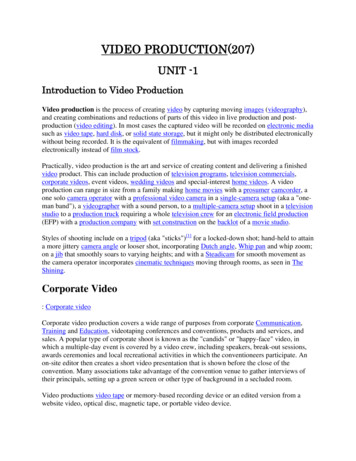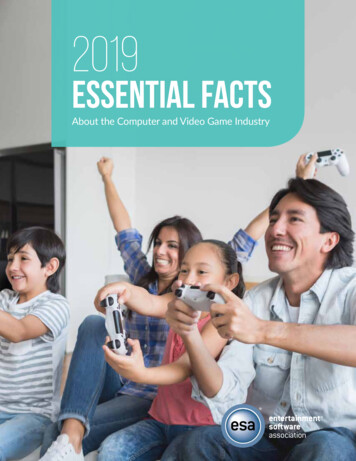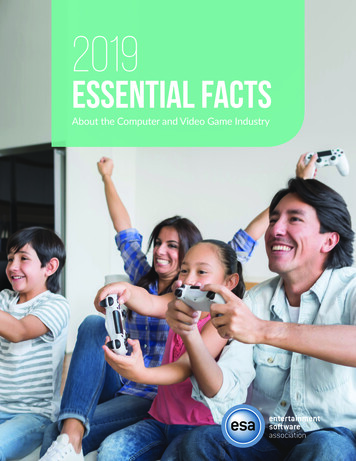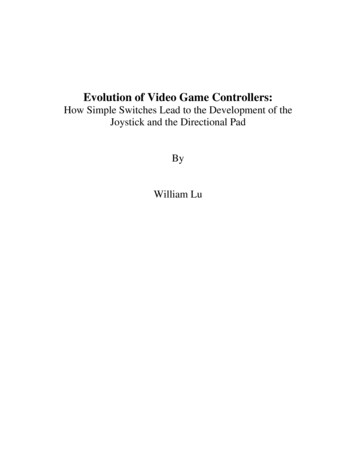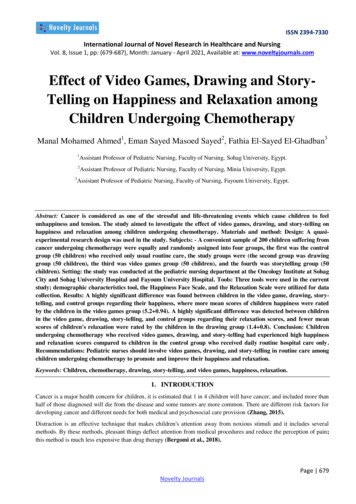
Transcription
ISSN 2394-7330International Journal of Novel Research in Healthcare and NursingVol. 8, Issue 1, pp: (679-687), Month: January - April 2021, Available at: www.noveltyjournals.comEffect of Video Games, Drawing and StoryTelling on Happiness and Relaxation amongChildren Undergoing ChemotherapyManal Mohamed Ahmed1, Eman Sayed Masoed Sayed2, Fathia El-Sayed El-Ghadban31Assistant Professor of Pediatric Nursing, Faculty of Nursing, Sohag University, Egypt.23Assistant Professor of Pediatric Nursing, Faculty of Nursing, Minia University, Egypt.Assistant Professor of Pediatric Nursing, Faculty of Nursing, Fayoum University, Egypt.Abstract: Cancer is considered as one of the stressful and life-threatening events which cause children to feelunhappiness and tension. The study aimed to investigate the effect of video games, drawing, and story-telling onhappiness and relaxation among children undergoing chemotherapy. Materials and method: Design: A quasiexperimental research design was used in the study. Subjects: - A convenient sample of 200 children suffering fromcancer undergoing chemotherapy were equally and randomly assigned into four groups, the first was the controlgroup (50 children) who received only usual routine care, the study groups were (the second group was drawinggroup (50 children), the third was video games group (50 children), and the fourth was storytelling group (50children). Setting: the study was conducted at the pediatric nursing department at the Oncology Institute at SohagCity and Sohag University Hospital and Fayoum University Hospital. Tools: Three tools were used in the currentstudy; demographic characteristics tool, the Happiness Face Scale, and the Relaxation Scale were utilized for datacollection. Results: A highly significant difference was found between children in the video game, drawing, storytelling, and control groups regarding their happiness, where more mean scores of children happiness were ratedby the children in the video games group (5.2 0.94). A highly significant difference was detected between childrenin the video game, drawing, story-telling, and control groups regarding their relaxation scores, and fewer meanscores of children's relaxation were rated by the children in the drawing group (1.4 0.8). Conclusion: Childrenundergoing chemotherapy who received video games, drawing, and story-telling had experienced high happinessand relaxation scores compared to children in the control group who received daily routine hospital care only.Recommendations: Pediatric nurses should involve video games, drawing, and story-telling in routine care amongchildren undergoing chemotherapy to promote and improve their happiness and relaxation.Keywords: Children, chemotherapy, drawing, story-telling, and video games, happiness, relaxation.1. INTRODUCTIONCancer is a major health concern for children, it is estimated that 1 in 4 children will have cancer, and included more thanhalf of those diagnosed will die from the disease and some tumors are more common. There are different risk factors fordeveloping cancer and different needs for both medical and psychosocial care provision (Zhang, 2015).Distraction is an effective technique that makes children's attention away from noxious stimuli and it includes severalmethods. By these methods, pleasant things deflect attention from medical procedures and reduce the perception of pain;this method is much less expensive than drug therapy (Bergomi et al., 2018).Page 679Novelty Journals
ISSN 2394-7330International Journal of Novel Research in Healthcare and NursingVol. 8, Issue 1, pp: (679-687), Month: January - April 2021, Available at: www.noveltyjournals.comDistraction methods include visual distraction (counting objects, watching TV), vocal distraction (listening to music),touch motion distraction (slow regular breathing), drawing, and purposive distraction (using toys). Other interventionsinclude relaxation, hypnosis, modeling, desensitization, contingency management, selective attention, stress inoculation,cognitive restructuring, and coping skills training (Abd El-Gawad et al., 2015).An audio-visual distraction like video games distraction is a simple method that helps nurses to solve the problem of lackof attention that diverts attention from a noxious stimulus through passively redirecting the subject's attention (Rezai etal., 2017). Video games distraction direct concentration to other and take the attention away from own pain andconcentrate on concern for someone else, more positive thoughts and distract with other sensations i.e. video gamesdistraction can jog emotions and break the connection between the person and his/her emotional pain (Kaheni et al.2016).Storytelling as a distraction technique reduces the amount of observed distress behavior among children undergoingchemotherapy (Shapiro, 2011). Also, children enjoy listening to stories that induce motivation and fun and make thempersonally involved in a story (Scott et al., 2010). Some researchers advocated that listening to short stories is aneffective technique used with the preschool child with cancer during hospitalization (Academy for Guided Imagery,2010).Drawing has a positive effect on happiness and relaxation levels by distracting children from situations of suffering in ahospital, and provides the experience of enjoyable events, as well as helping children to focus on play activities and feelrelaxed (William et al., 2016), and it is improving happy memories, and helps children to cope with difficult situations,which is reflected by lowering cortisol hormone levels and causes happiness and relaxation (Shah, 2017).The role of the pediatric nurse for children with cancer undergoing chemotherapy includes helping them to be emotionallystable, teach them relaxation techniques (Heinemann and Boyce, 2012). Nurses should help children to engage indrawing, story-telling, and video games activity and help in pain alleviation during procedures and the reduction of suchpain and fear because it is the responsibility of health care professionals is to improve children happiness and relaxationfor maintaining patient safety by using various pharmacological and non-pharmacological interventions (Lee and Yeo,2013). Nurses should relieve a child's suffering not only because of the consequences of unrelieved pain but also becausepain management may have benefits such as earlier mobilization, shortened hospital stays, and reduced costs (Harsh, etal., 2014).Significance of the study:Cancer causes negative effects on children, there are many activities to help children with cancer undergoingchemotherapy experience good feelings and making them feel happy and relaxed. There is a lack of studies that discussthe importance of video games, drawing, and story-telling on improving children's happiness and relaxation duringchemotherapy. So, the current study was to investigate the effect of video games, drawing, and story-telling on happinessand relaxation among children undergoing chemotherapy.Aim of the study:To investigate the effect of video games, drawing, and story-telling on the happiness and relaxation among childrenundergoing chemotherapy.Operational definitions:Relaxation is a state your body can learn where it is soft and loose and the mind is free from stress. Easily replacenegative and strict thoughts with soft, gentle, and positive ones. It helps to slow the heart rate, reducing the activity ofstress hormones, slowing your breathing rate, and helping you to naturally breath well by encouraging deeper breathing.Happiness is the state of feeling or showing pleasure or contentment. It isn’t a long-lasting, permanent feature orpersonality trait, but a more fleeting, changeable state.Research hypothesis:Children undergoing chemotherapy who received either video games, drawing, or story-telling will have significantlyhigher scores of happiness and relaxation compared to children in the control group.Page 680Novelty Journals
ISSN 2394-7330International Journal of Novel Research in Healthcare and NursingVol. 8, Issue 1, pp: (679-687), Month: January - April 2021, Available at: www.noveltyjournals.com2. SUBJECTS AND METHODResearch design:A quasi-experimental research design was used in this study.Setting:The study was performed in the pediatric department at the Oncology Institute at Sohag city and Sohag university hospitaland Fayoum University Hospital.Subjects:A convenient sample of 200 children undergoing chemotherapy from 6 to 12 years from the previously mentioned settingsix months from July 2020 to December 2020, who equally and randomly divided into four groups, the first was thecontrol group (50 children) who received only usual routine care, the second was drawing group (50 children), the thirdwas video games group (50 children), and the fourth was storytelling group (50 children).The inclusion criteria were:1. Children undergoing chemotherapy from both genders in the age group from 6-12 years.2. Conscious children.3. Can communicate with the researchers and cooperatively.Exclusion criteria1. Children under the effect of any anticonvulsant or analgesic drug.2. Children who are critically ill.Tools of data collection:Tool (I): An Interview Structured Questionnaire in addition to medical history about cancer, this tool was developed bythe researcher after reviewing the related literature; it included two parts as follow:Part 1: It included three questions related to the personal characteristics of the children as age, gender, and residencePart 2: It included two questions related to the medical data of the studied children about cancer which include durationof the disease and treatment.Tool (II): The Happiness Face Scale:It was adopted by Holder, (2010) to measure the happiness level of children which was modified from the Faces Scale. Itconsisted of seven faces on the original Face Scale for measuring happiness have the same eyes, different levels of asmile, with no explanations for the emotion of each face (distinguished by using the alphabet from A to G), with addingdetails of emotion to the face pictures, such as adding extra characteristics to the eyes, and the mouth or smile.The Happiness Face Scale had a single item question: "What is the feeling of your level of happiness (which meansfavorite, satisfied, or joyful or comfortable). The rating of happiness scores consists of 0 is considered most unhappy, veryunhappy is 1, a little unhappy is 2, indifferent is 3, a little happy is 4, very happy is 5, and most happy is 6. The lower thescores reflect the lower the happiness while the higher the score the higher the levels of happiness. The content validity ofthe Happiness Face Scale had been verified by three experts and the Content Validity Index (CVI) was 0.98. Reliability ofthe Happiness Face Scale (Cronbach’s Alpha 0.86).Tool (III): the Relaxation Scale:It was adapted by ELSA Support, (2015) to measure relaxation levels. It is modified by the Emotional Literacy SupportAssistant (ELSA) relaxation thermometer scale with permission. The original relaxation scale explains represent thefeelings of relaxation. Moreover, the higher score represents deep relaxation while the lower score represents anger, thescores by switching and changing the face pictures that represent the feelings of relaxation. The rating of relaxation scoresconsists of 0 is considered angry, frustrated or annoyed is 1, sad or upset is 2, beginning to calm down is 3, relaxed is 4,very relaxed is 5, and deeply relaxed is 6.Page 681Novelty Journals
ISSN 2394-7330International Journal of Novel Research in Healthcare and NursingVol. 8, Issue 1, pp: (679-687), Month: January - April 2021, Available at: www.noveltyjournals.comThe feeling of relaxation could be measured using one questionnaire by asking the question “What is the feeling ofyour level of relaxation (which means independence from pressure or stress)?.” Participants could select the answerfrom the picture which was similar to their feeling of relaxation that demonstrated their overall feeling of relaxation fromthe Relaxation Scale. The content validity of the Relaxation Scale had been verified by three experts and the ContentValidity Index (CVI) was 0.99. Reliability of the Relaxation Scale (Cronbach’s Alpha 0.82) (Lieff, 2017).Method of data collection:Before starting this study, administrative permission was obtained from the Dean of the Faculty of Nursing SohagUniversity. Administrative approval was obtained from managers in the previously mentioned setting.Data collection was conducted from the beginning of July 2020 to the end of December 2020. The interview wasconducted on two days each week from 9.00 a.m. to 12.00 p.m. Data collection was done during the routine work of theselected setting. The participants took about 20-30 minutes to fulfill the questionnaire and the other used tools werecompleted by the researchers.The video games were administered, through the researcher's laptop beside the routine care which contains funny andeducational games for about 30 minutes and was followed by assessing the happiness and relaxation scores amongchildren by using the happiness scale and relaxation scale.The drawing was administered, by giving the child a sketch and colored pencils for drawing beside the routine care andask them to draw what they want for about 15 minutes and followed by assessing the happiness and relaxation scoresamong children by using the happiness scale and relaxation scale.The storytelling was administered by the researchers besides the routine care and was followed by assessing the happinessand relaxation scores among children by using the happiness scale and relaxation scale. Telling the story took abouttwenty minutes by using a fun and educational story type that had made children feel happy. It is consisted of colorfulpages and attractive graphics and contained one line or one sentence per page. These stories are revolved around thingsthe child knows, such as his or her family and compassion for nature.The feeling of relaxation is measured using the Relaxation Scale by asking the question "What is the feeling of your levelof relaxation and ask the child to select the answer from the picture which was similar to their feeling of relaxation. Thescale was shown to the children and they were asked to choose their relaxation from numbers 0 to 6.Researchers explained for each face to help children understand the meaning of each face and to make it easier to decidewhich face picture was close to or similar to their feeling of happiness as well as for their feeling of relaxation.For the participants in the control group, they received the usual care (the standard care for pediatric patients undergoingchemotherapy in the ward consisted of drug administration, procedures, and nursing care to them normally given duringchemotherapy).The evaluation was done through video games or drawing or storytelling distraction techniques on happiness andrelaxation of children undergoing chemotherapy by faces, happiness scale, and relaxation scale.Tool validity and ReliabilityContent validity of the tools was determined and the content of the data collection tools was submitted to a panel of fiveexperts in Pediatric Nursing and Pediatric Oncology with more than ten years of experience in the field. Modifications ofthe tools were done according to the panel judgment on the clarity of sentences, appropriateness of the content, sequenceof items, and accuracy of scoring and recording of the items.Tools reliability was tested using internal consistency methods (Alpha Cronbach's test for the first tool, its result was 0.89which indicates good reliability of the tool.Pilot study:A pilot study was carried out on 10 % of the studied school-age children (20), for modification clarification andestimation of the time needed for filling the study tools and testing the feasibility of the research process. The unclearitems were clarified, unnecessary items were omitted and new items were added. Those who shared in the pilot studywere excluded from the study sample.Page 682Novelty Journals
ISSN 2394-7330International Journal of Novel Research in Healthcare and NursingVol. 8, Issue 1, pp: (679-687), Month: January - April 2021, Available at: www.noveltyjournals.comEthical consideration:Written consent was obtained from the mothers of the children. The researchers explained to each child and his mother theaim and benefit of the study. The mothers were informed that their participation is voluntary and had the ethical right toparticipates or refuse participation in the study and emphasized that their responses were confidential, and had their rightto withdraw from the study any time without giving further explanation. Privacy and confidentiality were resolutely keptin all data collection procedures.Statistical analysis:Data collected and analyzed by computer program SPSS" ver. 21" Chicago. Categorical variables were described bynumber and percent, where continuous variables were described by the means and standard deviation (M, SD). APearson's correlation is used to determine the significance between variables in the same group. Significance is consideredwhen P 0.05 while P 0.05 is considered not significant.3. RESULTSTable 1: Showed personal characteristics of children. Regarding the age, (55%), (50%), (52%), and (50%) of childrenwho received video games, drawing, story-telling, and control groups were mostly aged 8 10years with mean SD (4.37 0.74, 4.70 0.72, 4.54 0.63, and 4.60 0.81 respectively). Males were most prominent in video games, drawing,story-telling, and control groups (53%, 52, 60, and 61%respectively). As regard residence (61%), (47%), (45%), and(60%) of children who received video games, drawing, story-telling, and control groups were living in urban areasrespectively.Table 2: Demonstrated the medical diagnosis of children in video games, drawing, story-telling, and control groups. Theresults illustrated that no statistically significant difference was found between groups' different diagnoses as a braintumor, kidney tumor, leukemia, pelvic tumor, thyroid tumor, and pulmonary tumor. It was observed that leukemia wasmostly found between children in all groups.Table 3: Illustrated medical data among children in all studied and control groups and it was observed that (69%), (72%),(65%), and (75%) of children video games, drawing, story-telling, and control groups had cancer for one yearrespectively. The results showed (65%), (25%), (55%), and (63%) of children video games, drawing, story-telling, andcontrol groups were treated with infusion methods, while (35%), (75%), (45%), and (37%) of children were treated withinfusion & intramuscular methods.Table (4) indicated that there was a highly significant difference among video game, drawing, story-telling, and controlgroups regarding their happiness, where more mean scores of children happiness were rated by the children in the videogames group (5.2 0.94).Table (5) revealed that there was a highly significant difference in children's relaxation scores among the video game,drawing, story-telling, and control groups. Less mean scores of children relaxation were rated by the children in thedrawing group (1.4 0.8).Table (1): Frequency distribution of the studied children in video games, drawing, story-telling, and control groupsregarding their characteristics (n 200)ItemsVideo gamesgroup (n 50)NoAge: (years)6- 88 - 1010 – 12M SD%36285519394.37 0.74Drawinggroup(n 50)NoStory-tellinggroup (n 50)%510255020404.70 0.72Control group(n 50)No47265220414.54 0.63525204.60 0.81X2p-value%95041N.S0.237N.S0.917Page 683Novelty Journals
ISSN 2394-7330International Journal of Novel Research in Healthcare and NursingVol. 8, Issue 1, pp: (679-687), Month: January - April 2021, Available at: 232747532228455531196238N.S0.198N.S0.298N.S: Not significantTable (2): Frequency distribution of the studied children in video games, drawing, story-telling, and control groupsregarding medical diagnosis (n 200)DiagnosisBrain tumorKidney tumorLeukemiaPelvic tumorThyroid tumorPulmonary TumorVideo gamesgroup (n 50)No%36482347816112212Drawinggroup(n 50)No%51048204091871524Story-tellinggroup (n 50)No%51047204191871412Control group(n 50)No%4836214291881624p-value0.877 N.S0.787 N.S0.317 N.S0.706 N.S0.201 N.S0.211 N.SN.S: Not significantTable (3): Distribution of the studied children in video games, drawing, story-telling, and control groups regardingtheir medical data (n 200)Video gamesDrawinggroup (n 50) group(n 50)No%No%Duration of disease in years:1 year343669722 years112112233 years or more53105Type of chemotherapy as a treatment:Infusion33136525Infusion IM17353775ItemsStory-tellinggroup (n 50)No%Control group(n 963370.02*Table (4): Means differences of happiness among the studied children in the video game, drawing, story-telling,and control groups (n 200)ItemsHappiness scaleVideo gamesgroup (n 50)No%Drawinggroup(n 50)No%Story-tellinggroup (n 50)No%Control group(n 50)No%5.2 0.943.69 0.754.60 1.092.70 0.84X217.78p-value0.000(***) Statistically significant at p 0.0001Table (5): Means differences of relaxation among the studied children in a video game, drawing, story-telling, andcontrol groups (n 200)ItemsRelaxation scaleVideo game (n 50)No%4.85 1.01Drawinggroup (n 50)No%2.84 0.83Story-tellinggroup (n 50)No%2.55 1.18Control group(n 50)No%1.4 0.8X26.4p-value0.000(***) Statistically significant at p 0.0001Page 684Novelty Journals
ISSN 2394-7330International Journal of Novel Research in Healthcare and NursingVol. 8, Issue 1, pp: (679-687), Month: January - April 2021, Available at: www.noveltyjournals.com4. DISCUSSIONDistraction is considered the most effective procedure to increase happiness and relaxation during routine care. So thestudy aimed to investigate the effect of video games, drawing, and story-telling on the happiness and relaxation ofchildren with cancerThe results of the present study revealed that males were most prominent in video game, drawing, story-telling, andcontrol groups. The study's results are in the same line with the results conducted by the worldwide organization, (2016)which reported that the cancer incidence in male was higher than in the female. Also, these findings are agreed with ElSayed et al., (2019), who carried out a study about "Effect of Story-Telling on Reducing the Intensity of Nausea andVomiting among Children Undergoing Chemotherapy" among 100 children in Sohag city and found the same.The results of the present study indicated that leukemia was mostly found between children in all groups as a medicaldiagnosis of children in video games, drawing, story-telling, and control groups. These results were following a studyconducted by Abdel Hadi, (2010) who studied comprehensive care in pediatric cancer patients and mentioned that acutelymphatic leukemia was the most common type of cancer in children, and El Sayed et al., (2019) also, reported the samefindings.The current study revealed that more than two-thirds of video game, drawing, story-telling groups and three-quarters ofchildren in the control group had cancer for one year respectively. This finding is similar to the study conducted byHassan, (2015) about "Effect of Guided Imagery Relaxation Session and Story-Telling on the Intensity of Nausea andVomiting among Children Undergoing Chemotherapy" and found that approximately one-half of children had cancer forless than 6 months. Similarly, Abd El Razik (2010) who conducted a study about "Effect of Educational Program onQuality of life for patients with cancer undergoing chemotherapy" found that more than two-thirds of children developedcancer for less than one year. This is attributed to delayed cancer discovery among the young age of children.The results of the current study showed that approximately two thirds, one quarter, more than half, and less than twothirds of children in video games, drawing, story-telling, and control groups were treated with infusion methods, whilemore than one third, three quarters, less than half and more than one-third of children were treated with infusion &intramuscular methods.These results are supported with the results conducted by Hassan, (2015) who reported in his study in Tanta city about"Effect of Guided Imagery Relaxation Session and Story-Telling on the Intensity of Nausea and Vomiting amongChildren Undergoing Chemotherapy" that treatment was either administered for children intravenously or Intrathecally.Also, these results are similar to Abd El Hadi, (2010) who stated that the majority of children received chemotherapythrough different routes depending on the type of cancer and the chemotherapy drugs used.The results of the current study indicated that there was a highly significant difference among video game, drawing, storytelling, and control groups regarding their happiness and there was a highly significant difference of children's relaxationscale among the video game, drawing, story-telling, and control groups. This may be due to children's attention wasoccupied by distraction technique activation was reduced in the areas of the brain (Martin, 2010).These results are supported by Kodchakon et al., (2018) who conducted a study in Thailand about "A RandomizedControl Trial of Guided-Imagination and Drawing-Storytelling in Children with Cancer" and found that children withcancer who received GIM and computer drawing- storytelling had significantly higher scores for happiness, relaxation,and lower levels of vital signs representing more relaxation.Also, are in agreement with Abd El-Gawad et al., (2015) who studied the effect of interactive distraction versuscutaneous stimulation for venipuncture pain relief among 100 Egyptian children at Ain Shams University Hospitals andfound that distracting technique was effective in the reduction of pain during a routine procedure for hospitalized children.Also, Cerne et al. (2015) who conducted a study about "A Randomized Controlled Trial Examining the perspective froma developing country. Journal of Effectiveness of Cartoons as a Distraction Child Health Care " and found that proceduresin oncology departments and distraction technique before and during procedures had benefits because it is cheap andeasily available, require less staff and accepted by the children and their families and there is no harm to children and itcan increase the children participation and improve their coping in another experience.Page 685Novelty Journals
ISSN 2394-7330International Journal of Novel Research in Healthcare and NursingVol. 8, Issue 1, pp: (679-687), Month: January - April 2021, Available at: www.noveltyjournals.com5. CONCLUSIONThe current study concluded based on the results and study hypothesis that children undergoing chemotherapy whoreceived video games, drawing, and story-telling had experienced high happiness and relaxation scores compared tochildren in the control group who received daily routine hospital care only.6. RECOMMENDATIONS1. Pediatric nurses should involve video games, drawing, and story-telling in routine care to promote and improve thehappiness and relaxation of children with cancer2. Parents' education and nurses about video games, drawing, and story-telling as distraction techniques for children withcancer.3. Types of equipment that used for distraction techniques should be available in the hospitals such as toys, attractivebooks, puppets, video games, bubbles, and drawing equipment as a sketch and colored pencils for drawing that distractsthe children and hold their attention.REFERENCES[1] Abd El Razik, S. (2010): Effect of educational program on quality of life for patients with cancer undergoingchemotherapy, doctoral Degree, Faculty of Nursing, Benha University.[2] Abd El-Gawad S M and Elsayed L A. (2015): Effect of interactive distraction versus cutaneous stimulation forvenipuncture pain relief in school-age children. Journal of Nursing Education and Practice, 5(4): 32-40.[3] Abdel Hadi S. (2010): Comprehensive care in pediatric cancer patient, Pediatric oncology NCI, Egypt. Retrievedfrom www.nic.ed.eg.accessed.[4] Academy for Guided Imagery, (2010): Certification training. Retrieved from: http//www. Academy for GuidedImagery.com[5] Bergomi P, Scudeller S, Pintaldi A, and Dal Molin. (2018): Efficacy of non-pharmacological methods of painmanagement in children undergoing venipuncture in a pediatric outpatient clinic: A Randomized Controlled Trial ofAudiovisual Distraction and External Cold and Vibration, Journal of Pediatric Nursing 42. May, DOI:10.1016/j.pedn.2018.04.011[6] Cerne D L, Sannino and Petean MA., (2015): Participation in the care of a hospitalized child: A RandomisedControlled Trial Examining the perspective from a developing country, Journal of Effectiveness of Cartoons as aDistraction Child Health Care. Online publication DOI: Technique. Nurs Child Young People, 27(3): 28-33.10.1177/136749351559865.[7] Drawing-Storytelling in Children with Cancer, Pacific Rim Int J Nurs Res; 22(4) 386-400[8] El Sayed S A, Hekmat Ibrahim, Nahid Thabet Mohamed, and Manal Mohamed Ahmed (2019): Effect of storytelling on reducing the intensity of nausea and vomiting among children undergoing chemotherapy, Article17, Volume 7, Issue 17, Spring 2019, Page 164-172. DOI: 10.21608/ASNJ.2019.56979.[9] ELSA Support (2015): Relaxation thermometer. Available from: r[10] Harsh V, Vivek V, Amanlo K, Ruku S, Neha C, and Krushnan V. (2014): Comparison between the analgesic effectof two techniques on the level of pain perception during venipuncture in children up to 7 Years of Age: A QuasiExperimental Study, Manag; 5(6):425-34.[11] Hassan A. Gh. (2015): "Effect of guided imagery relaxati
in the video game, drawing, story-telling, and control groups regarding their relaxation scores, and fewer mean scores of children's relaxation were rated by the children in the drawing group (1.4 0.8). Conclusion: Children undergoing chemotherapy who received video games, drawing, and story-telling had experienced high happiness



